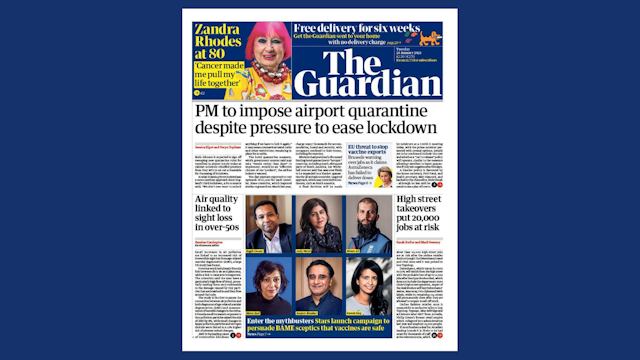
Advertisement

Vaccine campaign 2
Created for the communities, by the communities, on Thursday #TaketheVaccine took over TV channels, urging those from BAME backgrounds to get the jab. The Drum finds out the story behind this stunt and how it pushed the marginalized message into the headlines.
At 9.56pm on Thursday 18 February, ITV, Channel 4, Channel 5, UKTV and Sky all took a simultaneous break from their programming to deliver an urgent message to Black, Asian and minority ethnic (BAME) groups. The message was clear: take the vaccine, save lives.
The unprecedented television moment indicated how serious the current situation is. While overall Covid-19 vaccine acceptance in the UK is pretty high (85% of adults are very likely to get the jab), almost 10 million people are more averse – and it is heavily skewed towards BAME communities.
According to fresh NHS research, a lower proportion of ethnic minorities have received at least one vaccine dose up to 27 January, while Black over-80s in England are half as likely as white people to have the Covid-19 jab.
The findings point to negligence by ministers in targeting these communities. Talking to The Guardian in early February, Halima Begum, chief exec of the Runnymede Trust, insisted: “This isn’t about vaccine refusal, because that very rhetoric implies that these communities are doing something wrong.
“We need to balance the conversation away from hesitancy and uptake to the response to BAME groups and their institutional mistrust now, and how they might be supported to show trust back in our public services like the NHS and the police.”
Media Hive specializes in multicultural BAME community outreach. Since the beginning of the pandemic, it has been creating Covid awareness campaigns that talk to those audiences, alongside TV broadcaster and presenter Adil Ray. ”We realized there wasn’t enough communication when it came to ethnic community audiences,” recalls managing director Samir Ahmed. And so the team got celebrities onside, using their platform to help reach audiences that the general awareness campaigns missed.
Acting as creative director throughout, Ray has directed and wrote scripts for all the videos, were used on social media, getting the stars to record clips on their phones.
Under the ‘stay at home’ messaging, Ahmeh explains that they made it culturally relevant for different communities, in the languages some of these communities speak as their first. They also put out messaging for religious holidays, advising how to celebrate Ramadan or Eid at home.
“Every minority community in the country had a religious holiday last year,“ he explains. “And it’s not just religion. With the Black Lives Matter protests, the guidance was to stay at home. But for the Black community, this was a big moment.
“We’ve spent too much time not engaging properly with these communities. Which is why we’re at this point now. With the vaccine hesitancy, we need to ask: have we spent too long not engaging with these communities properly?“
Ahmed details how they used non-traditional media formats to reach these audiences, instead of mainstream TV. ”It’s a specialist kind of targeting work, which is why social media like WhatsApp is really important for that.”
And so on the back of their success, Ray called Ahmed up in January, highlighting that there was a big issue at the moment with vaccine hesitancy. He asked: ”Shall we do another one?” And as they had done on the campaigns previous, they went to their celebrity contacts to get them on board.
“It’s a video that was created for the communities, by the communities,” says Ahmed, explaining on how they ensured they got the messaging right on this sensitive issue. “Every community has different concerns when it comes to the vaccine – they’ve all expressed that there are different cultural barriers.
“It’s not to take anything away from the guidance and voice of doctors, but we’re offering an alternative. Celebrities can also be influential – they have a platform to spread the word. They also have lived experience. They are the people in the videos, they’ve had the experience. There’s a lot of taboo subjects that don’t get spoken about in households or between families, for cultural reasons.“
He adds that all the points raised are fact-checked by the NHS: “The whole point of these videos is to make sure we’re not spreading misinformation. We need the right information, spoken by the right people, promoted to the right platforms.
Since it was originally launched four weeks ago, the video has been watched thousands of times. But considering some ethnic minorities don’t watch mainstream television, why did they choose to take over the TV channels on Thursday?
“The ethnic minority story is one that doesn’t get the headlines,“ Ahmed explains. “Unfortunately, it’s always fourth or fifth on the agenda. So what we’ve managed to do with our three and a half minute film, is put it higher up the agenda. To show the community that this is an issue, at a national level. We hope it will blow the doors open for further conversations. Once you’ve had that, it should lead to the right decision.“

And so while it may not reach those audiences live, the media attention the moment received has rippled further afield. Since its launch back in January, the campaign has appeared on the front of a number of newspapers, including The Sun and The Guardian.
And, beyond the big national TV broadcast, the campaign and video have been recognized and shared by the prime minister and the Prince of Wales, as well as several Cabinet ministers including the health secretary, home secretary and the vaccines minister.
It also has gone out-of-home with the messaging, working alongside Clear Channel and ad agency Engine Group, who offered creative support in bringing it all to life in conjunction with the TV rollout.
You can watch the full #TaketheVaccine TV campaign here: